Source: The Pipeline, Medium; Compiled by: Deng Tong, Golden Finance
Monad Labs CEO and Co-Founder Keone Hon and Developer Relations Engineer Kevin G participated in the third episode of The Pipeline Podcast This episode discusses the work of the Monad Labs team over the past two years. Why rebuild EVM from scratch? Please read carefully to find out.
Guest background:
Keone previously worked as a quantitative analyst in the high frequency (HFT) field of Jump Trading division. It was here that he met and worked with Monad co-founder and CTO James Hunsaker for the first time. Most recently, Kevin G worked as a core developer at Solana Labs (previously at Apple, focusing on native systems engineering for Airpods).
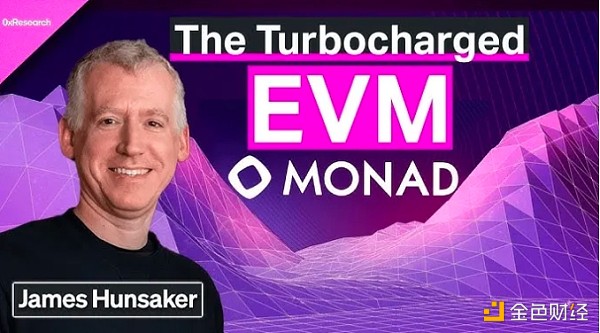
Monad's CTO James Hunsaker works closely with Jump Trading's CEO Keone (Source: 0xResearch)
< h3>Q: Why Monad? In an environment where L2 and other scaling solutions are so popular, why would you want to retrofit EVM?
Keone:
A few years ago, when we first started, a lot of people asked us, "Why not build an L2?" Our answer then was the same as it is now: We Think someone needs to focus on improving the performance of the EVM execution stack. By introducing optimizations such as parallel execution, custom state databases, pipelined execution, and asynchronous IO support, Monad will be able to better utilize hardware to enable higher-performing, decentralized systems.
As time goes on, it becomes increasingly clear that many of the bottlenecks in the Ethereum Virtual Machine can be solved and optimized by the right team of engineers. Back in 2020, when Monads were first conceptualized, there weren’t many teams focused on these optimizations, especially when you compare it to the effort put into other infrastructure (Rollup, zero-knowledge proofs, or data availability).
As the dominant standard for smart contracts, the EVM chain has (so far) the majority of TVL, the largest developer and research network, and an incredible amount of money that has stood the test of time (and multiple bear markets) community. This makes optimization even more important as we look to scale adoption and support more complex applications.
"Improving the performance of the EVM is indeed an interesting and challenging problem. I'm glad our team started paying attention to this while we were doing it." In the coming months I'm so excited to show it to the world. ”
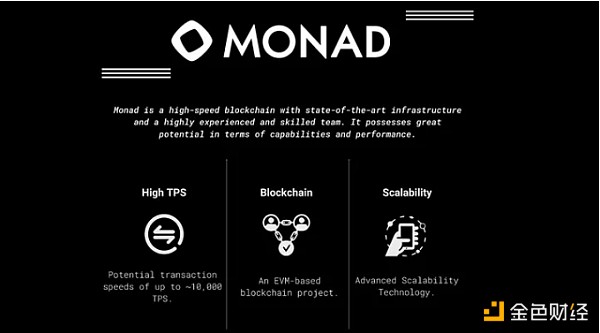
EVM performance meets the scalability on Monad.
Kevin G:
A lot of what Monad is doing is computer science best practices applied to blockchain networks. This is possible because the team has such a deep background in this space.
Not every development team Both are working on solving the fundamental problems of the protocol and coming up with high-performance solutions. Not only are these optimizations exciting; they are inherently ambitious. This has never been done before.
Q: You How do you build a team that can handle this challenge?
Keone:
I'm really lucky to have a great group of engineering people at Monad Labs, as well as growth, marketing, community people in construction and business development. We have about 25 employees and try to stay super lean to focus on the problems that need to be solved.
Our team will continue to grow over time to Support the scale and adoption we're trying to achieve. This will definitely require a broader skill set and additional manpower.
Most engineering teams have extensive experience building high-performance, low-latency systems. Developing truly high-performance A common pattern with performance base layer systems is that you need expert knowledge of overall system performance. Sometimes you need to drill down to the kernel level to get the optimizations you want. Ultimately, the blockchain itself is effectively a database.
< p>

Some beloved Monad characters have cemented their place in community lore.
Q: Why creators should check out Monads?
Keone:
A key advantage of Monads is that it has the potential to facilitate broad composability, beyond the existing limitations of Ethereum and even beyond higher performance ones such as Solana system.
Because Monads are compatible with EVM bytecode and RPC, the learning curve for engineers is much lower than in many other environments. We are excited and excited to leverage the wealth of research and tooling that is paving the way for EVM to thrive and enable developers to build higher-performing, scalable environments in an environment they already know and trust. app.
Q: What is Monad’s strategic positioning within broader Layer 1 solutions?
Keone:
The ultimate goal is to create a more scalable and cost-effective platform for building diverse applications, removing the barriers that prevent existing blockchain ecosystems from being composable sexual restrictions.
In the context of Ethereum’s original design: its purpose was to enable builders to create anything within its ecosystem. Monads are an accelerated development of this concept, freed from limitations that have existed for over a decade. The transition from gasoline-powered cars to electric cars can serve as an analogy to mark the paradigm shift that can be achieved when new technology is introduced.
Consider the practical challenges Ethereum developers face due to gas limitations. There are many more applications and features possible on Ethereum, but are disabled due to excessive fees. One of the main goals of Monads is to free existing EVM applications from the constraints of current gas limitations.
Monad also leverages the rich existing code and products in the EVM ecosystem, providing a platform for ambitious builders to truly build dApps that are not possible elsewhere.
Overall, the focus of Monads is on the collective nature of the crypto community. The current phase is an experimental one, with cryptocurrency enthusiasts building applications for decentralized personal finance. Monad aims to make these applications more cost-effective, unlocking their true potential to scale to a wider user base.
Q: What types of applications are you most excited to see on Monad?
Keone:
For me there are two areas - decentralized finance (DeFi) and consumer-facing applications.
DeFi
Anything that allows ordinary people to manage their personal finances in a decentralized way. And of course there are applications like currency markets, decentralized exchanges, derivatives, high-fidelity and high-scale oracles. This is a vertical that I'm really excited about.
Before joining Monad, I was a member of the Jump crypto team. Jump is deeply involved in the Solana ecosystem and excited about it because it makes sense. If the cost is only a fraction of a cent and you can scale to millions of users, you could actually have a financial product that essentially replaces what existing incumbents are currently doing. Centralized exchanges charge very high fees for data.
One of the reasons we love Solana is that it’s great technology. Despite its lack of EVM compatibility (which can make the development experience tricky), Solana has come a long way since James and I worked on it in 2021.
Consumer Applications:
I’m also very excited about the consumer-facing applications on Monad. For example, sports betting, casino, social; basically anything that makes sense on a phone as a mobile app.
It will be easier for me to interact with apps, services, and content if I know all my data is in my wallet; this is because the wallet is cryptographically secure. For example, a shopping application that contextualizes an individual's personal experiences and preferences (on-chain) makes a lot of sense for the shopping user experience.
Q: What aspects of the EVM interest you most about the Monad route?
For me, it's about building something that ultimately helps the greatest number of developers scale their applications. Ultimately, Monad is a developer platform. It’s important to go where developers are and solve their real pressing problems. I think pure EVM compatibility is part of the solution to these problems, but there will be others in the future that essentially make it easier and cheaper to support more cryptographic features.
Ultimately, this is just about solving the problems that prevent developers from building apps that rank #1 in the iOS store. For me, I feel like EVM is the best place to do that.
Surprisingly, no one really pays attention to the execution stack. It was a very natural place to work, given our team’s previous backgrounds, and the urgency with which we felt the problem needed to be solved.
Monad proposes this path where the ideals of EVM and the Ethereum community have a chance to truly reach product scale.
"Ultimately, Monad is a really cool combination where we can get a Solana-like user experience on the EVM. Developers can then choose where they want to build based on the needs of the system."
Cooperation is indeed important. Our team realizes we don’t have all the answers. We are experts. We know a lot about building high-performance parallel systems, Byzantine fault-tolerant consensus, and other very specific problems. But there are also many people invested in research on Ethereum, focusing on issues such as MEV minimization, governance, and cryptography. So I think it's also important to follow standards and that the work you do can be combined with other people's work.
Kevin G:
EVM is the nexus of much applied cryptography research, a huge effort to build applications, and a huge effort to develop better security practices. It's great to be able to hit the mark and help push the entire field forward.
Because of this, we can focus deeply on scaling the base layer - which is what we do well - while leveraging the research community's expertise in this area. Additionally, we don't have to rebuild all the developer tools already provided for EVM.
Q: What is the biggest challenge in supporting builders in an EVM environment?
Keone:
I think there are a few. It's very challenging for developers to attract funding at the moment; the investor community is very biased against the United States. For international developers, getting funding is really difficult.
Additionally, building dApps is challenging from a security perspective. There are plenty of black hat hackers constantly probing for vulnerabilities and looking for vulnerabilities. This makes it a very hostile environment. We need better security practices, including gas optimization.
By significantly reducing gas costs, Monads solve a huge compromise for developers; whether to include additional defensive assertions (which cost more gas).
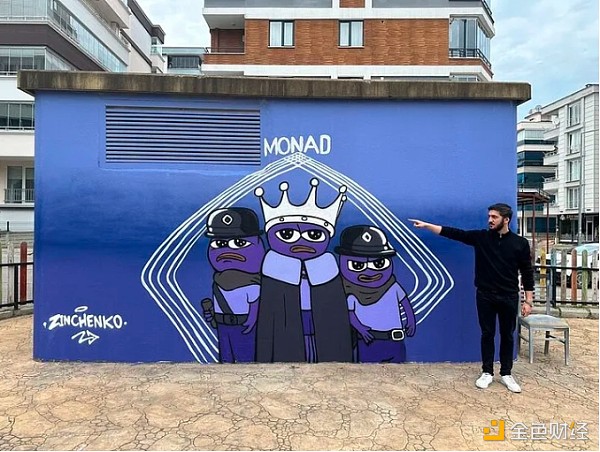
A Monad community member displays his new mural in Turkey.
Q: An overlooked advantage of building crypto products?
Keone:
It’s amazing how strong the crypto community is. If you were building a traditional tech startup, you would have no Twitter followers. You can post an update and no one will care. No one will be eager to try your product.
In the cryptocurrency space, we have such a strong community (which is really a core part of its ethos), which is actually a huge advantage over other areas of technology and what cryptocurrency ultimately achieved. the key to success. It's really just about leveraging the strengths and minimizing the weaknesses; then we can scale as an industry.
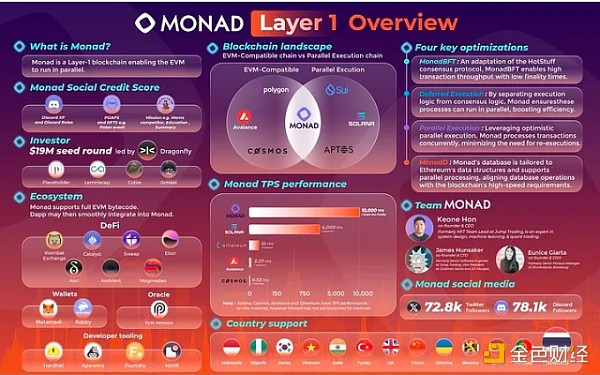 < span style="font-size: 14px;">Starting in November 2023, the community produced an early ecosystem map for Monad.
< span style="font-size: 14px;">Starting in November 2023, the community produced an early ecosystem map for Monad.
As an industry, blockchain is just beginning to mature. Over time, blockchains will become more performant (so much so that I wouldn't expect Monad to be different from other blockchains just because of its performance).
Other systems will make additional improvements, and there will be a crossover of ideas or a crossover of technologies. This ultimately advances the field and enables the building of higher performing applications. We will continue to push the limits of blockchain and introduce additional infrastructure support for new implementations.
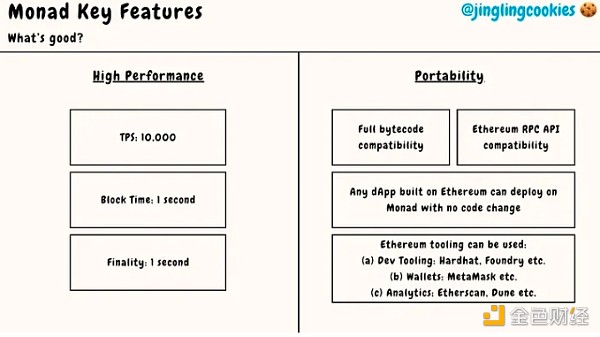
Q: Encrypt Twitter There is a lot of discussion about TPS as a general trading and voting trading indicator. When is TPS a valuable metric?
Keone:
Regarding the general measurement of TPS, we believe that it should only count real transactions, smart contract interactions, and transfers that occur on the chain: not just voting transactions. For Monads, we do not include voting in any TPS presentation.
Generally speaking, there is a lot of confusion about what should count as a real transaction. Many teams use different metrics to calculate trades. It's a very non-uniform space right now in terms of how different teams promote performance. For example, some treat transactions as instructions. So if there is a smart contract call that executes multiple sub-instructions underneath it, others will count it as ~10 transactions, which is incorrect.
The only thing you can really measure is the number of transactions that go through the system. If, at any given moment, the system is not fully loaded, the actual observable TPS will be much lower. So there's a lot of confusion there as well.
I think the real solution is to have repeatable benchmarks in a GitHub repository. Each team is expected to contribute to this repository and push a complete script that defines deployment to many different servers around the world. The script will then be able to send a bunch of transactions to various nodes in the system and actually produce a full transaction throughput test.
This is something our team plans to introduce, at least for Monad, but hopefully for other competitive benchmarks as well. This is similar to the normal process of scientific research, where you must publish not only the results, but also the procedures used to generate those results. This way, third parties can replay the experiments and reproduce these benchmarks. This is very important to us and is what we intend to do.
 JinseFinance
JinseFinance
 JinseFinance
JinseFinance JinseFinance
JinseFinance JinseFinance
JinseFinance JinseFinance
JinseFinance JinseFinance
JinseFinance JinseFinance
JinseFinance JinseFinance
JinseFinance JinseFinance
JinseFinance JinseFinance
JinseFinance JinseFinance
JinseFinance